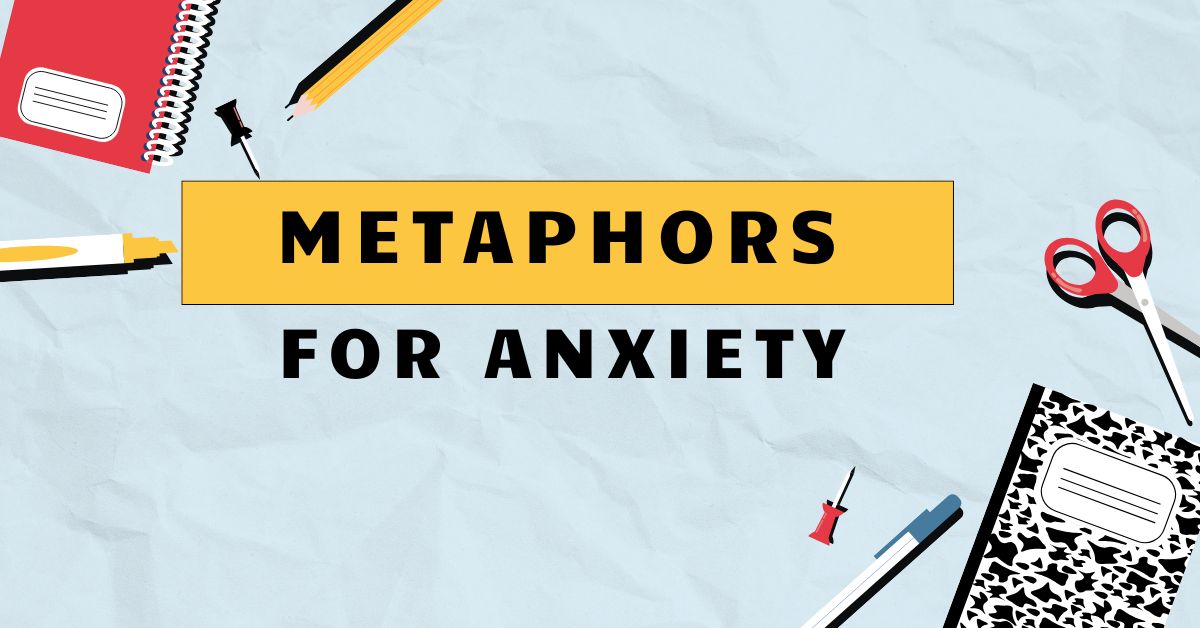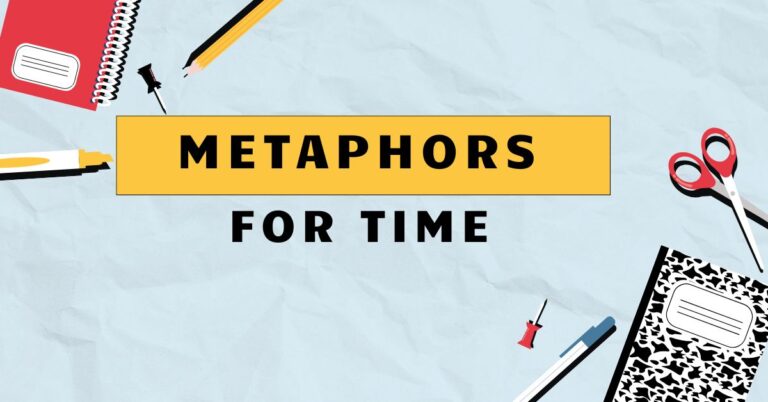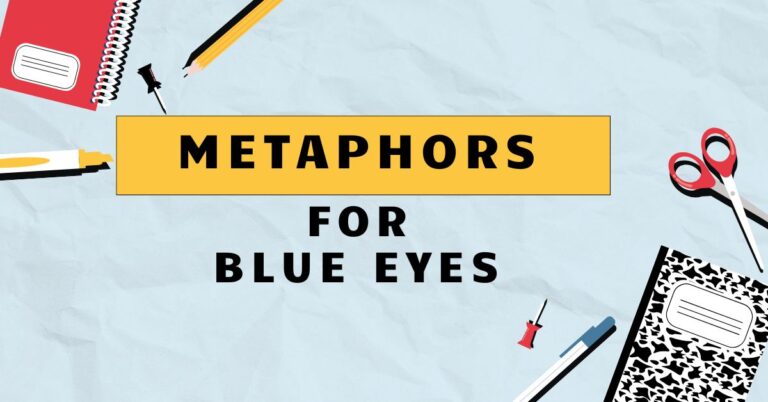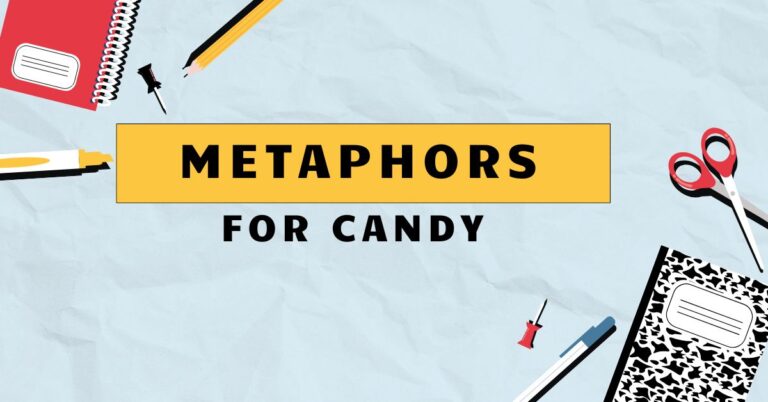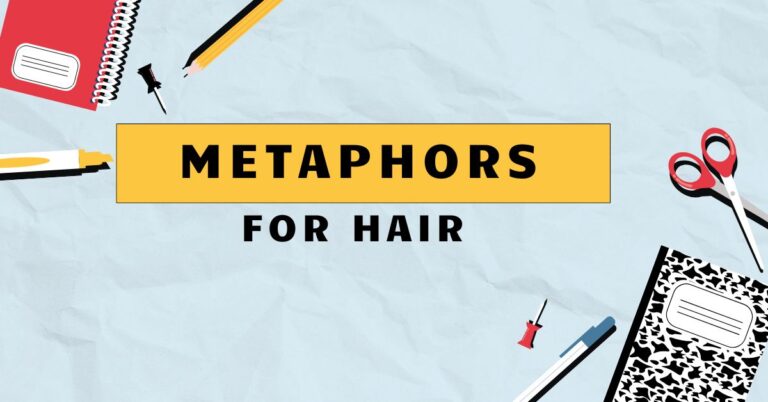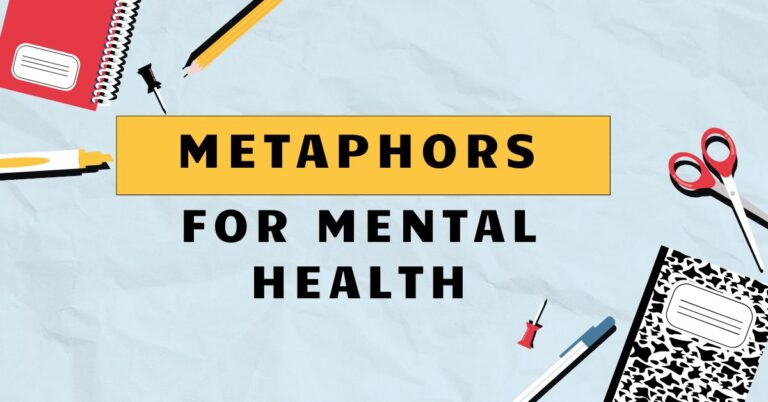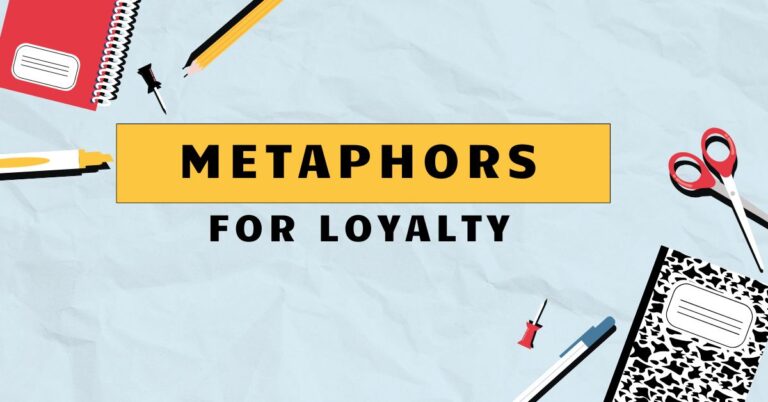49 Metaphors for Anxiety: Understanding and Usage
Anxiety, often an invisible and deeply personal experience, can be challenging to articulate. Metaphors provide a powerful tool for expressing the complex feelings and sensations associated with anxiety, allowing individuals to communicate their experiences in a vivid and relatable way.
Understanding these metaphors not only enhances our comprehension of anxiety but also improves our ability to empathize with and support those who experience it. This article explores the various metaphors used to describe anxiety, their structural elements, and how they can be effectively used in communication and literature.
It is designed for English language learners, mental health professionals, and anyone interested in expanding their understanding of anxiety through the lens of figurative language.
Table of Contents
- Introduction
- Definition of Metaphor and Anxiety
- Structural Breakdown of Anxiety Metaphors
- Types of Metaphors for Anxiety
- Examples of Anxiety Metaphors
- Usage Rules for Anxiety Metaphors
- Common Mistakes with Anxiety Metaphors
- Practice Exercises
- Advanced Topics in Anxiety Metaphors
- Frequently Asked Questions
- Conclusion
Definition of Metaphor and Anxiety
Ametaphoris a figure of speech that directly compares two unrelated things, asserting that one thing *is* another. Unlike similes, which use “like” or “as” to make a comparison, metaphors imply a resemblance.
The purpose of a metaphor is to provide a new perspective or understanding of a subject by associating it with something familiar. Metaphors are crucial for expressing abstract concepts in a tangible way, making them invaluable in literature, poetry, and everyday communication.
Anxietyis a complex emotion characterized by feelings of worry, nervousness, or unease, typically about an event or something with an uncertain outcome. It can manifest physically through symptoms like increased heart rate, sweating, and difficulty breathing.
Anxiety disorders are a group of mental health conditions that involve excessive and persistent worry, fear, or apprehension. Because anxiety is an internal experience, it is often difficult to describe directly, making metaphors a vital tool for externalizing and communicating these feelings.
Structural Breakdown of Anxiety Metaphors
Anxiety metaphors typically consist of two main elements: thetenorand thevehicle. The tenor is the subject being described (in this case, anxiety), and the vehicle is the object or concept used to represent the tenor.
The relationship between the tenor and the vehicle creates the metaphorical meaning.
For example, in the metaphor “Anxiety is a storm,” the tenor is “anxiety,” and the vehicle is “storm.” The metaphor suggests that anxiety shares characteristics with a storm, such as its intensity, unpredictability, and overwhelming nature. Understanding this structure helps in both interpreting and creating effective metaphors for anxiety.
Effective anxiety metaphors often tap into common experiences or imagery that resonate with a wide audience. This allows for a deeper understanding and empathy towards those expressing their anxiety through these figures of speech.
The power of a metaphor lies in its ability to evoke a strong emotional response and provide a fresh perspective on a difficult subject.
Types of Metaphors for Anxiety
Anxiety as a Storm
This is a common metaphor, portraying anxiety as a turbulent and overwhelming force. It emphasizes the feeling of being swept away by intense emotions and the lack of control one might experience.
Phrases like “a brewing storm of anxiety” or “caught in a whirlwind of worry” are typical examples.
Anxiety as a Weight
This metaphor focuses on the burden and heaviness that anxiety can bring. It suggests that anxiety is a constant pressure that weighs down the individual, making it difficult to move forward or function effectively.
Examples include “the weight of anxiety on my chest” or “carrying the heavy load of worry.”
Anxiety as a Prison
This metaphor highlights the feeling of being trapped or confined by anxiety. It suggests that anxiety limits one’s freedom and prevents them from living a full and meaningful life.
Phrases like “imprisoned by my anxiety” or “trapped in the cage of fear” illustrate this type of metaphor.
Anxiety as an Animal
This metaphor often portrays anxiety as a wild or untamed force within, something that is difficult to control and can be unpredictable. Examples include “anxiety gnawing at my insides” or “the beast of anxiety lurking in the shadows.” The animalistic imagery emphasizes the primal and instinctive nature of anxiety.
Anxiety as a Machine
This metaphor depicts anxiety as a relentless, often malfunctioning, mechanism. It might focus on repetitive thoughts or physical symptoms that feel automated and beyond conscious control.
Examples include “my mind is a runaway engine of anxiety” or “the gears of worry grinding in my head.”
Examples of Anxiety Metaphors
The following tables provide a variety of examples of anxiety metaphors, categorized by type. These examples illustrate the different ways that anxiety can be expressed through figurative language.
Table 1: Anxiety as a Storm
This table provides examples of how anxiety can be metaphorically described as a storm, emphasizing its overwhelming and turbulent nature. The examples illustrate the intensity and unpredictability often associated with anxiety.
| Metaphor | Explanation |
|---|---|
| Anxiety is a tempest raging within me. | Describes anxiety as a violent and destructive storm inside the person. |
| My mind is a hurricane of worries. | Compares the mind to a powerful and chaotic storm filled with worries. |
| I’m drowning in a sea of anxiety. | Implies being overwhelmed and suffocated by anxiety. |
| A storm of panic washed over me. | Suggests a sudden and intense wave of panic. |
| Anxiety is the thunder that never stops. | Portrays anxiety as a constant and ominous presence. |
| The clouds of anxiety are gathering. | Indicates a growing sense of unease and impending anxiety. |
| My heart is a drum in the storm of my anxiety. | Connects the physical symptom of a racing heart to the overall feeling of anxiety. |
| I feel like a ship lost in a stormy sea of anxiety. | Highlights the feeling of being disoriented and helpless in the face of anxiety. |
| Anxiety is the lightning that strikes without warning. | Emphasizes the unpredictable and sudden nature of anxiety attacks. |
| The rain of anxiety is pouring down on me. | Suggests a constant and unrelenting feeling of worry and unease. |
| I’m caught in the crosswinds of anxiety. | Describes the feeling of being pulled in different directions by conflicting worries. |
| The floodgates of anxiety have opened. | Implies an overwhelming release of pent-up anxiety. |
| Anxiety is the dark cloud hanging over my head. | Portrays anxiety as a constant and oppressive presence. |
| I’m weathering the storm of anxiety. | Suggests resilience and the ability to cope with anxiety. |
| The waves of anxiety are crashing over me. | Emphasizes the feeling of being overwhelmed by intense emotions. |
| Anxiety is the eye of the storm, calm but dangerous. | Suggests that even in moments of apparent calm, anxiety remains a threat. |
| My thoughts are scattered like debris in a hurricane of anxiety. | Describes the disorganization and chaos of anxious thoughts. |
| I’m navigating the treacherous waters of anxiety. | Highlights the challenges and difficulties of dealing with anxiety. |
| The storm of anxiety has left me exhausted and drained. | Emphasizes the physical and emotional toll of anxiety. |
| Anxiety is the aftermath of the storm, the lingering damage. | Suggests that the effects of anxiety can persist even after the initial episode has passed. |
| The barometer of my anxiety is rising. | Indicates an increasing level of anxiety. |
| I’m bracing myself for the coming storm of anxiety. | Suggests preparing for an expected period of high anxiety. |
| The storm of anxiety is relentless and unforgiving. | Emphasizes the persistent and harsh nature of anxiety. |
Table 2: Anxiety as a Weight
This table provides examples of how anxiety can be metaphorically described as a weight, emphasizing the burden and pressure it exerts on an individual. These metaphors highlight the feeling of being weighed down and restricted by anxiety.
| Metaphor | Explanation |
|---|---|
| Anxiety is a heavy burden on my shoulders. | Describes anxiety as a significant weight that is difficult to bear. |
| I’m carrying the weight of the world on my chest. | Implies feeling responsible for everything and overwhelmed by worry. |
| Anxiety is like a lead vest, slowing me down. | Suggests that anxiety hinders progress and makes it difficult to move forward. |
| I’m weighed down by the anchor of my fears. | Highlights the feeling of being trapped and unable to escape from fears. |
| Anxiety is a ton of bricks on my heart. | Portrays anxiety as a crushing and oppressive force. |
| The weight of anxiety is crushing me. | Emphasizes the overwhelming pressure and burden of anxiety. |
| I’m lugging around a suitcase full of worries. | Describes the feeling of constantly carrying around anxieties and concerns. |
| Anxiety is a chain around my ankles, holding me back. | Suggests that anxiety restricts freedom and prevents one from achieving goals. |
| I feel like I’m sinking under the weight of my anxiety. | Implies being overwhelmed and unable to cope with anxiety. |
| Anxiety is a heavy cloud hanging over me. | Portrays anxiety as a constant and oppressive presence. |
| I’m shouldering the burden of anxiety every day. | Emphasizes the daily struggle and effort required to manage anxiety. |
| Anxiety is like carrying a mountain on my back. | Highlights the immense and exhausting nature of anxiety. |
| I’m burdened by the weight of unspoken fears. | Describes the pressure of keeping anxieties hidden and unaddressed. |
| Anxiety is the heavy cloak I can’t take off. | Suggests that anxiety is a constant and inescapable part of one’s life. |
| I feel trapped under the weight of my own expectations. | Highlights the pressure to meet high standards and the anxiety it creates. |
| Anxiety is a stone in my stomach, making me sick. | Connects the physical symptoms of anxiety to the overall feeling of unease. |
| I’m struggling under the weight of past traumas. | Describes the burden of unresolved past experiences and their impact on anxiety. |
| Anxiety is a heavy debt I can’t seem to repay. | Suggests that anxiety is a lingering consequence of past events or choices. |
| I’m drowning in the weight of my responsibilities. | Implies being overwhelmed by the demands and obligations of life. |
| Anxiety is the heavy armor I wear to protect myself. | Suggests that anxiety is a defense mechanism, but also a burden. |
| The weight of anxiety is pulling me under the surface. | Emphasizes the feeling of being dragged down by intense emotions. |
| Anxiety is a heavy chain that binds me to my fears. | Describes the feeling of being restricted and controlled by anxiety. |
| I’m carrying the weight of other people’s expectations. | Highlights the pressure to meet the demands and desires of others. |
| Anxiety is a heavy load that never gets lighter. | Emphasizes the persistent and unrelenting nature of anxiety. |
Table 3: Anxiety as a Prison
This table presents metaphors that depict anxiety as a prison, highlighting the feeling of being trapped and restricted by its influence. These examples emphasize the limitations and confinement imposed by anxiety.
| Metaphor | Explanation |
|---|---|
| Anxiety is a prison, and I’m serving a life sentence. | Describes anxiety as a long-term confinement with no end in sight. |
| I’m trapped in the cage of my own mind. | Implies being confined by one’s own thoughts and worries. |
| Anxiety is the bars that keep me from living freely. | Suggests that anxiety prevents one from experiencing life to the fullest. |
| I’m locked in the dungeon of my fears. | Highlights the feeling of being trapped and isolated by fears. |
| Anxiety is the walled garden I can’t escape. | Portrays anxiety as a beautiful but confining space. |
| I feel imprisoned by my own thoughts and worries. | Emphasizes the feeling of being trapped by one’s internal mental state. |
| Anxiety is a maze with no exit. | Describes the feeling of being lost and unable to find a way out of anxiety. |
| I’m confined to the four walls of my anxiety. | Suggests that anxiety limits one’s world and experiences. |
| Anxiety is the invisible fence that keeps me in place. | Highlights the unseen but powerful restrictions imposed by anxiety. |
| I feel like a bird trapped in a gilded cage of anxiety. | Portrays anxiety as a beautiful but ultimately confining experience. |
| Anxiety is the solitary confinement of my mind. | Emphasizes the isolation and loneliness of dealing with anxiety. |
| I’m trapped in the echo chamber of my own fears. | Describes the feeling of being surrounded and amplified by one’s own anxieties. |
| Anxiety is the iron curtain that separates me from the world. | Suggests that anxiety creates a barrier between oneself and others. |
| I’m locked away in the tower of my own insecurities. | Highlights the feeling of being isolated and vulnerable due to insecurities. |
| Anxiety is the inescapable orbit of my worries. | Portrays anxiety as a constant and inescapable cycle of worry. |
| I feel like a prisoner of my own making. | Emphasizes the feeling of being responsible for one’s own anxiety. |
| Anxiety is the barbed wire fence around my heart. | Describes the feeling of being guarded and protected, but also isolated, by anxiety. |
| I’m stuck in the revolving door of my anxious thoughts. | Suggests that anxiety is a repetitive and inescapable cycle. |
| Anxiety is the locked room I can’t find the key to. | Highlights the feeling of being unable to escape or resolve anxiety. |
| I feel like a puppet controlled by the strings of anxiety. | Portrays anxiety as a force that manipulates and controls one’s actions. |
| Anxiety is the magnetic field that pulls me back to my fears. | Describes the feeling of being drawn back to anxious thoughts and behaviors. |
| I’m trapped in the hamster wheel of my anxious routines. | Suggests that anxiety leads to repetitive and unproductive behaviors. |
| Anxiety is the inescapable shadow that follows me everywhere. | Emphasizes the persistent and omnipresent nature of anxiety. |
Table 4: Anxiety as an Animal
This table provides metaphors that use animalistic imagery to describe anxiety, emphasizing its primal, instinctive, and sometimes uncontrollable nature. These metaphors highlight the feeling of anxiety as an internal force that is difficult to tame.
| Metaphor | Explanation |
|---|---|
| Anxiety is a serpent coiling in my stomach. | Describes anxiety as a sinister and constricting presence. |
| I feel like a caged animal, pacing with anxiety. | Implies a restless and agitated state due to confinement. |
| Anxiety is a swarm of bees buzzing in my head. | Suggests a chaotic and overwhelming sensation of irritation and unease. |
| I’m being hunted by the hounds of my own fears. | Highlights the relentless pursuit and torment of one’s own anxieties. |
| Anxiety is a pit bull gnawing at my insides. | Portrays anxiety as an aggressive and destructive force. |
| I feel like a trapped rabbit, paralyzed by fear. | Emphasizes the feeling of being helpless and frozen in the face of danger. |
| Anxiety is a venomous spider spinning webs of worry. | Describes anxiety as a toxic and ensnaring force. |
| I’m being pecked to death by the crows of my concerns. | Suggests that small but persistent worries can be overwhelming. |
| Anxiety is a nocturnal beast that only comes out at night. | Highlights the tendency for anxiety to worsen during periods of rest or inactivity. |
| I feel like a cornered wolf, ready to lash out at any moment. | Emphasizes the feeling of being threatened and defensive due to anxiety. |
| Anxiety is a parasitic worm feeding on my peace of mind. | Describes anxiety as a destructive force that drains one’s well-being. |
| I’m being stalked by the shadow of my own anxiety. | Suggests that anxiety is a constant and menacing presence. |
| Anxiety is a raven croaking ominous warnings in my ear. | Highlights the feeling of impending doom and negativity associated with anxiety. |
| I feel like a frightened mouse, scurrying to avoid danger. | Emphasizes the feeling of being constantly on edge and avoiding potential threats. |
| Anxiety is a barracuda lurking in the depths of my mind. | Describes anxiety as a hidden and predatory force. |
| I’m being swarmed by the locusts of my worries. | Suggests that worries are consuming and devouring one’s mental state. |
| Anxiety is a wild horse that I can’t control. | Highlights the feeling of being unable to manage or direct one’s anxiety. |
| I feel like a wounded bird, unable to fly away from my fears. | Emphasizes the feeling of being vulnerable and unable to escape anxiety. |
| Anxiety is a pack of wolves circling my thoughts. | Describes the feeling of being surrounded and threatened by anxious thoughts. |
Table 5: Anxiety as a Machine
This table provides metaphors that depict anxiety as a machine, emphasizing its repetitive, relentless, and sometimes malfunctioning nature. These metaphors highlight the feeling of anxiety as an automated process that is difficult to control.
| Metaphor | Explanation |
|---|---|
| Anxiety is a runaway engine in my mind. | Describes anxiety as a process that is out of control and accelerating. |
| My thoughts are stuck on repeat, like a broken record. | Implies a repetitive and inescapable cycle of anxious thoughts. |
| Anxiety is a machine gun firing worries at me nonstop. | Suggests a relentless and overwhelming barrage of anxious thoughts. |
| I feel like a robot programmed to worry. | Highlights the feeling of being controlled and compelled by anxiety. |
| Anxiety is a malfunctioning alarm constantly blaring in my head. | Portrays anxiety as a persistent and irritating warning signal. |
| My mind is a factory churning out worst-case scenarios. | Emphasizes the tendency for anxiety to generate negative and catastrophic thoughts. |
| Anxiety is a computer virus corrupting my thoughts. | Describes anxiety as a destructive force that damages one’s mental state. |
| I feel like a cog in the machine of my own anxiety. | Highlights the feeling of being a small and insignificant part of a larger, uncontrollable process. |
| Anxiety is a printing press churning out worries on demand. | Suggests that anxiety is a readily available and easily triggered process. |
| My heart is a drum machine beating out of rhythm with my anxiety. | Connects the physical symptoms of anxiety to the overall feeling of unease. |
| Anxiety is a generator powering my fears. | Describes anxiety as a source of energy that fuels one’s anxieties. |
| I feel like a broken clock, constantly ticking with anxiety. | Emphasizes the feeling of being trapped in a repetitive and unproductive cycle. |
| Anxiety is a conveyor belt of worries passing through my mind. | Suggests that worries are constantly moving and circulating without resolution. |
| My thoughts are racing like a high-speed train out of control. | Highlights the feeling of being overwhelmed by the speed and intensity of anxious thoughts. |
| Anxiety is a short circuit in my brain, causing chaos. | Describes anxiety as a malfunction that disrupts normal mental processes. |
Usage Rules for Anxiety Metaphors
When using metaphors for anxiety, it’s essential to consider the following rules to ensure clarity and effectiveness:
- Relevance: The vehicle should be relevant to the tenor. The comparison should highlight meaningful similarities between anxiety and the chosen object or concept.
- Consistency: Maintain consistency in the metaphor throughout the communication. Avoid mixing metaphors that create confusing or contradictory images.
- Clarity: The metaphor should be easily understandable. Avoid obscure or overly complex comparisons that may confuse the audience.
- Sensitivity: Be mindful of the audience and the context. When discussing mental health, use metaphors that are respectful and avoid trivializing the experience of anxiety.
Common Mistakes with Anxiety Metaphors
Here are some common mistakes to avoid when using metaphors for anxiety:
- Mixed Metaphors: Combining unrelated metaphors that create a confusing image.
- Incorrect: “Anxiety is a storm that nipped me in the bud.” (Combining a storm with a plant metaphor)
- Correct: “Anxiety is a storm raging within me.”
- Clichéd Metaphors: Using overused metaphors that lack originality and impact.
- Incorrect: “Anxiety is a monster.” (Too generic and lacks specificity)
- Correct: “Anxiety is a shadow that follows me, growing larger in the dark.”
- Insensitive Metaphors: Using metaphors that trivialize or belittle the experience of anxiety.
- Incorrect: “Anxiety is just a little rain.” (Downplays the severity of the condition)
- Correct: “Anxiety is a flood that threatens to overwhelm me.”
It’s important to choose metaphors that accurately and respectfully convey the experience of anxiety. By avoiding these common mistakes, you can communicate more effectively and empathetically.
Practice Exercises
Test your understanding of anxiety metaphors with these exercises.
Exercise 1: Identifying Metaphors
Identify the metaphor in each sentence and explain what aspect of anxiety it highlights.
| Question | Answer |
|---|---|
| 1. My anxiety is a relentless current pulling me under. | Metaphor: Relentless current. Highlights: Overwhelming and uncontrollable nature of anxiety. |
| 2. The knot of anxiety tightens in my stomach. | Metaphor: Knot. Highlights: Physical discomfort and tension associated with anxiety. |
| 3. I’m navigating a minefield of social situations. | Metaphor: Minefield. Highlights: The feeling of danger and uncertainty in social interactions. |
| 4. Anxiety is a relentless chatter in my mind. | Metaphor: Relentless chatter. Highlights: The constant and intrusive nature of anxious thoughts. |
| 5. My anxiety is a fog that obscures my clarity. | Metaphor: Fog. Highlights: The feeling of confusion and lack of focus caused by anxiety. |
| 6. I am walking through quicksand of uncertainty. | Metaphor: Quicksand. Highlights: The feeling of being trapped and sinking deeper into anxiety. |
| 7. Anxiety is a puppeteer, pulling the strings of my actions. | Metaphor: Puppeteer. Highlights: The feeling of being controlled and manipulated by anxiety. |
| 8. Each day I climb the mountain of anxiety. | Metaphor: Mountain. Highlights: The difficulty and effort required to manage anxiety daily. |
| 9. I stumble through the labyrinth of my fears. | Metaphor: Labyrinth. Highlights: The feeling of being lost and confused by anxiety. |
| 10. Anxiety is a relentless judge always scrutinizing my actions. | Metaphor: Relentless judge. Highlights: The feeling of being constantly evaluated and criticized by anxiety. |
Exercise 2: Completing Metaphors
Complete the following sentences by adding a suitable metaphor for anxiety.
| Question | Answer |
|---|---|
| 1. My anxiety is like __________, making it hard to breathe. | …a tight band around my chest… |
| 2. I feel as though my anxiety is __________, constantly watching me. | …a lurking shadow… |
| 3. Living with anxiety is like __________, always on high alert. | …walking on eggshells… |
| 4. When anxiety hits, my mind becomes __________. | …a battlefield… |
| 5. The uncertainty fuels my anxiety, which is __________. | …a raging fire… |
| 6. My anxiety feels like __________, never letting me rest. | …a broken record… |
| 7. It feels like I am __________, struggling to get out. | …drowning in my worries… |
| 8. The weight of my anxiety is __________. | …a mountain on my shoulders… |
| 9. During panic attacks, my mind is __________. | …a tangled web… |
| 10. Anxiety is often __________, limiting my world. | …a closed door… |
Advanced Topics in Anxiety Metaphors
For advanced learners, exploring the cultural and historical context of anxiety metaphors can provide deeper insights. Different cultures may use different metaphors to describe anxiety based on their unique experiences and beliefs.
For example, some cultures may associate anxiety with spiritual or supernatural forces, while others may focus on social or economic factors.
Additionally, analyzing the use of anxiety metaphors in literature and art can reveal how these figures of speech have evolved over time and how they reflect changing attitudes towards mental health. Examining the works of authors and artists who have personally experienced anxiety can provide particularly powerful examples of the use of metaphor to convey complex emotions.
Another advanced topic is the development of personalized metaphors for anxiety. Encourage individuals to create their own metaphors that resonate with their unique experiences.
This can be a therapeutic exercise that promotes self-awareness and helps individuals to better understand and communicate their anxiety.
Frequently Asked Questions
- What is the difference between a metaphor and a simile?
A metaphor directly compares two things by stating that one *is* the other, while a simile uses “like” or “as” to make a comparison. For example, “Anxiety is a storm” (metaphor) versus “Anxiety is like a storm” (simile).
- Why are metaphors useful for describing anxiety?
Metaphors help to express the often intangible and complex feelings associated with anxiety in a more concrete and relatable way. They allow individuals to communicate their experiences more effectively and foster empathy from others.
- Can metaphors for anxiety be harmful?
Yes, if they are used insensitively or trivialize the experience of anxiety. It’s important to choose metaphors that are respectful and avoid downplaying the severity of the condition.
- How can I create my own metaphors for anxiety?
Reflect on your personal experiences with anxiety and identify objects, concepts, or situations that share similar characteristics. Consider the physical sensations, emotional states, and behavioral patterns associated with your anxiety.
- Are certain types of metaphors more effective than others?
The effectiveness of a metaphor depends on the individual and the context. Some people may find certain types of metaphors more relatable or impactful than others. Experiment with different metaphors to find what works best for you.
- How can understanding anxiety metaphors help me support someone with anxiety?
By understanding the metaphors that someone uses to describe their anxiety, you can gain a deeper insight into their experience and offer more effective support. You can also use similar metaphors to communicate your understanding and empathy.
- Can metaphors be used in therapy to treat anxiety?
Yes, metaphors can be a valuable tool in therapy. Therapists may use metaphors to help clients understand their anxiety, challenge negative thoughts, and develop coping strategies. Creating and exploring personal metaphors can also be a therapeutic exercise.
- Are there any cultural differences in the way anxiety is described metaphorically?
Yes, different cultures may use different metaphors to describe anxiety based on their unique experiences, beliefs, and values. For example, some cultures may associate anxiety with spiritual or supernatural forces, while others may focus on social or economic factors.
- How can I avoid using clichéd metaphors for anxiety?
Strive for originality by considering specific aspects of your anxiety and finding unique comparisons. Avoid overused metaphors like “anxiety is a monster” and instead, try to create more descriptive and personalized metaphors.
- Is it okay to mix metaphors when describing anxiety?
<is generally best to avoid mixing metaphors, as it can create confusion and weaken the impact of your message. However, in some cases, a carefully crafted mixed metaphor can be effective if it is used intentionally and serves a specific purpose.
Conclusion
Metaphors are powerful tools for understanding and expressing the complex experience of anxiety. By using metaphors, individuals can communicate their feelings in a vivid and relatable way, fostering empathy and understanding from others.
Whether you are an English language learner, a mental health professional, or simply someone interested in expanding your understanding of anxiety, mastering the use of anxiety metaphors can enhance your communication skills and deepen your appreciation for the nuances of human emotion. Remember to use metaphors thoughtfully, with sensitivity and clarity, to ensure that your message resonates with your audience and accurately reflects the experience of anxiety.

